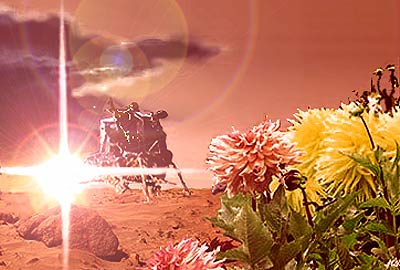Needed: a change of focusby Hans L.D.G. Starlife
|
| In the minds of people, the whole idea of spaceflight is strongly associated with science. |
Recently, it was also highlighted in the report “United States Space Policy: Challenges and Opportunities”, by the American Academy of Arts & Sciences, where they are not at all happy with the idea of going places like the Moon and Mars “just because they are there”. Even more recently, the debate surfaced in some newspaper editorials, which argued that because the shuttle and its tank still loses some bits and pieces, we should cancel human spaceflight all together—permanently—and only focus only on robotic missions!
In the minds of people, the whole idea of spaceflight is strongly associated with science. Ask people in the streets what they are thinking when they hear the word “space”, or a university student when you say “space careers”. Certainly, they are not thinking about cooking or gardening! It’s all about achieving breakthroughs in science and engineering. And if it’s not, it’s probably not worth the money—ask your nearest politician!
Even an energetic scientist like Carl Sagan, whom I had the fortune to discuss this topic with, knew that space is about so much more than science. However, most people are terribly shortsighted. Few care about the long-term perspectives presented by visionaries like Sagan, John Young, and now Martin Rees; that our choices stand between spaceflight and extinction.
The solution here is not to engage harder in the human vs. robot debate, presenting better arguments, but rather to shift the entire focus away from this discussion about rewards, creating a new focus. Otherwise, we will continue to face an endless uphill battle. How can we ever “win” the humans vs. robot debate, when the issue at stake not even comes close to our goal of colonizing?
Compare it with another topic: our long-time fascination with possible intelligent life in the universe. For decades, the debate was very much focused on UFOs, sightings and abduction stories. Alien visitors turned into a modern myth. In an age when our other beliefs and ideologies were fading away, we could at least believe in UFOs.
| We now need to sow the seeds of a new “myth” for the space program—in fact a whole new perception among people regarding our inherited place, role, and destiny in the cosmos. |
Most scientists, annoyed as they were, simply chose to ignore it. Then some bright people, like my colleagues in The Planetary Society, realized that instead of just laughing at the matter, you could try to tap this truly huge interest for life in space, by shifting the focus to a related but more scientific theme: SETI. Since then, there are more articles about SETI than UFOs in our newspapers. They managed to shift the center of the debate, and to a small degree, they shifted our entire perception of the universe.
In a similar fashion, we now need to sow the seeds of a new “myth” for the space program—in fact a whole new perception among people regarding our inherited place, role, and destiny in the cosmos. I am sure we won’t influence policymakers and budget planners right away. But we can make this seed grow in society at large: why not start already tonight with our kids’ bedtime stories?
For this purpose, I find Michael Huang’s aesthetic Space Flag design quite fitting, with its deep symbolism of seeds and flowers representing life and growth in the cosmos. There we have the foundations for a new, beautiful, space-age vision capable of attracting a much larger audience, including more women: to help the universe to come alive, to sow the gift of life on those worlds who didn’t quite make it, and increasing our chances of survival in the process.
Others have already been on a similar path, including a few scientists. Chris McKay, the well-known Mars scientist at NASA’s Ames Research Center, suggested that a flower could ride along a spacecraft to Mars, inside a special glass canister, blooming under the Martian skies for people back on Earth to see. Regardless of its scientific value, it would make a great symbolic impact among the taxpayers. However, the NASA managers, back at that time, failed to see this connection.
Today, one of McKay’s colleagues, Margarita Marinova, is making big headlines with her own research and visions for the greening of Mars. And although they are both scientists, working with observing nature, it’s easy to see that they are dreaming bigger dreams in their coffee breaks, dreams about expanding nature.
Michael Huang’s Space Flag is not the first such proposal. There have been several similar flag proposals over the years, including Earth flags, Earth-Moon flags, Sun-Earth-Moon flags, and Mars flags. They normally survive only a few years before they fade away into history. However, as a former artist, I definitely think Huang’s proposal is the most beautiful one, nicely matching the shift in focus I have called for.
However, I don’t expect any space flag to become official for some time, just like the international space agency Taylor Dinerman so strongly criticized (See “More international delusions”, The Space Review, August 15, 2005.) Principally I am a supporter of this initiative as well, but the problems Dinerman stated are very real. So right now—regrettably to me but probably not to him—our primitive preoccupation with trying to dominate the world and building Roman Empires seems to be the quickest route to the stars.
However, while we humans are waiting to grow up and fully open our petals, we can always start by sowing the seeds: the new vision of our role in the universe... and at least an underground space flag!
